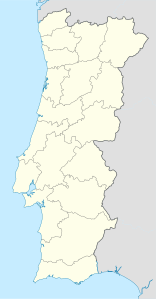Gruta do Escoural
| Gruta do Escoural
|
||
|---|---|---|
| Location: | Santiago do Escoural , Portugal | |
|
Geographic location: |
38 ° 32 '39 " N , 8 ° 8' 16.5" W | |
|
|
||
| Type: | Stalactite cave | |
| Discovery: | 1963 | |
| Particularities: | Palaeolithic finds , cave paintings | |
The Gruta do Escoural ( German "Grotto of Escoural" ) is a cave that is located about three kilometers east of the city of Santiago do Escoural in Portugal .
history
The cave is on the site of a marble quarry and was discovered during blasting in 1963. An artificial access to the rear part of the stalactite cave was created, today's entrance. The original access was on the southern slope of the rocks and was buried. After the discovery, an archaeological study of the cave sediments is carried out.
Old Stone Age
The oldest use of the cave by the Neanderthals took place during the Middle Paleolithic and is attested by some quartz artifacts .
Escoural became known as the only Portuguese cave with wall paintings (black and red line drawings) and engravings from the Paleolithic . They consist of abstract motifs, but above all of zoomorphic representations (horses, cattle). The research has given indications of a relative chronology . The oldest pictures are black figurative line drawings, followed by engravings with U- and V-shaped line sections . Above that there are drawings in red. The most recent are fine-line engravings. For stylistic reasons, the representations are dated to the middle and upper solutre .
Neolithic
During the Neolithic and / or the Copper Age , the cave served as a burial place. The dead were placed on the cave floor with the additions ( ceramics , stone axes , blades, etc.). The lime-saturated water dripping from the ceiling covered the skeletons and additions with a hard layer of lime. Absolute data, obtained from the bones of this layer, date the necropolis to the middle of the 3rd millennium BC. Chr.
Surroundings of the cave
On the rock above the cave are the remains of a Copper Age fortification, reinforced with semicircular bastions, of the so-called Castro culture , most of which fell victim to the quarry. On the rocks below are z. Sometimes rich engravings with bucrania , simple bowls and other motifs.
About 500 m from the cave, a tholos was discovered and excavated on a hill in 1964 .
Scientific collections
In the museum of Montemor-o-Novo you can see colored slides from the cave and a small selection of finds. The remaining finds from the cave and from the Tholos are in the Museu Nacional de Arqueologia in Lisbon .
Current situation
The cave was already considered a national monument (Monumento Nacional) by the Portuguese state in 1963 and placed under protection. Linked to this was the cessation of blasting and quarrying in the vicinity of the cave. The opening up of the cave for the professional public and tourism brought with it the installation of lighting systems and the leveling of paths. As a result, the microclimate changed to the detriment of the cave: moisture and light promoted the growth of introduced bacteria, fungi and mosses. According to information from the French University of Bordeaux , much greater attention had to be paid to protecting the original color pigments and the interior of the cave. With the help of international experts, the Portuguese government has drawn up a national strategic framework plan for this unique cultural monument. Technical precautions (including a climate monitoring system) are being put in place to protect the environmental conditions in the cave, and access will be severely restricted in the future to prevent microbiological contamination. At the same time, the Montemor-o-Novo museum is to be upgraded.
Web links
- Archaeological Circuits in Alentejo and Algarve (English / Portuguese)
- Gruta do Escoural The Megalithic Portal (English)
literature
- Ana Cristina Araújo, Marylise Lejeune: Gruta do Escoural. Necropole neolithica e arte rupestre paleolithica. Instituto Portugues de Arquêologia, Lisbon 1995, ( Trabalhos de arqueologia 8).
- Antonio Carlos Silva: Escoural
Individual evidence
- ↑ Lusa: Grutas do Escoural vão ser requalificadas. Diaro Digital, July 22, 2009, accessed on February 11, 2011 (Portuguese): “The work to restore the cave, which should be completed by the end of the year (2009), is the responsibility of the Alentejo regional cultural authority, which is responsible for the Carry out the project as a National Strategic Framework (NSRF). (As obras de requalificação das Grutas do Escoural, que deverão estar concluídas no final deste ano, são da responsabilidade da Direcção Regional de Cultura do Alentejo, que candidatou o projecto ao Quadro de Referência Estratégico Nacional QREN). "


